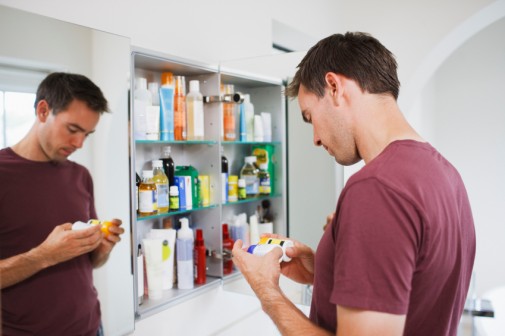How to organize your medicine cabinet

Keeping your medications and first-aid products organized will save you time when a cold or injury strikes. If you have children, safely storing medication will keep your kids safe from an accidental overdose.
Where you keep them organized is another important consideration. According to Rolla Sweis, Pharm.D, pharmacy director at Advocate Christ Medical Center in Oak Lawn, Ill., medications are best kept away from humid areas, like bathrooms, and out of direct sunlight and away from heat sources.
“I recommend people keep medications where they are most likely to remember to take them and where there is enough light to easily read the label,” says Dr. Sweis. “The kitchen is often a great place, as many medications need to be taken with water or food.”
She advises using a drawer or upper cabinet for storing those items that aren’t used daily, but in an area that is away from the stove or other sources of heat.
While there is no one perfect way to organize medications, here are some tips you may find helpful:
Prepare:
- Gather all prescription and over-the-counter drugs, ointments, medicated creams and first-aid essentials.
- Dispose of any expired medications and recycle the empty containers. Also throw away any product that looks damaged or those you won’t use. It’s good to do this once a year.
- If you don’t have the original container, make sure everything is properly labeled with the expiration date.
- Make a list of items that you need to purchase to restock your medicine/first-aid cabinet.
Organize:
- Find a central spot in the house to store all medications where everyone, except young children and those will mental disabilities, will have easy access. It’s best to keep other items, such as personal toiletries, in a different area.
- A medicine cabinet does not have to be the traditional cabinet recessed into the wall in your bathroom. You can use a drawer, a container on a shelf or even a bag to keep everything organized.
- If you have young children in your house, make sure you choose an area that can be locked or is high enough that everything is out of reach.
- If you have a multiple person household, keep a separate container of medication(s) specific for each person, and use a different one for shared items: band-aids, aspirin, cough drops, etc.
- If you have products many people in the family use (like aspirin, over-the-counter allergy medications and bandages), organize them in different containers labeled with the contents: cold & sinus, pain medications, first-aid items, etc., making it easy for everyone to find what they need.
Storing daily medications:
Dr. Sweis recommends these tips:
- If you have medications you take on a daily basis, it might be better to keep these in a visible place so you remember to take them.
- If you take multiple medications each day, you may find the use of a daily pill box beneficial.
- If more than one person in the house takes prescription medication, be sure to separate each person’s prescriptions into separate containers and clearly label each container.
Related Posts
Comments
2 Comments
About the Author
Kate Eller was a regional director of public affairs and marketing operations for Advocate Health Care. She enjoys road trips, dogs, minimalism, yoga, hiking, and “urban hiking.”


















The bathroom medicine cabinet is the WORST place to store medicines…the fluctuating heat and humidity will cause faster deterioration of medicines. Best to keep them on a closet shelf, bedroom drawer or kitchen cabinet away from heat source. Also, do not store meds in refrigerator unless directions specify to do so.
I like what this article mentions about keeping medicine away from areas with high moisture. I’m looking at remodeling my bathroom and relocating my medicine cabinet in the process. I’ll have to look at places that don’t get a lot of foot traffic to help avoid any problems. Thanks for sharing!